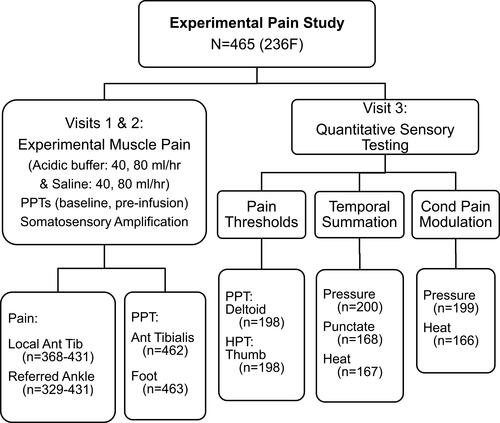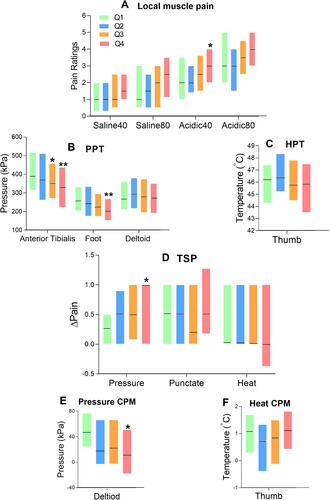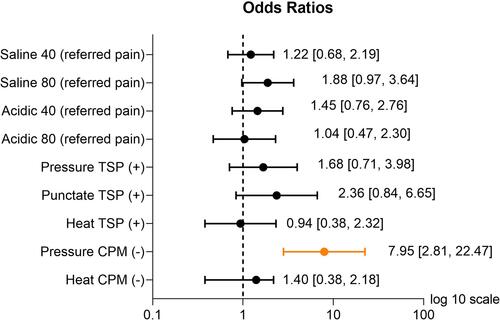Figures & data
Figure 1 The schematic study design framework of the pain sensitivity assessments and associated sample sizes.

Table 1 Seven Items (Unshaded) from the 10-Item Somatosensory Amplification Scale (SSAS) Used to Assess Multisensory Sensitivity
Table 2 Characteristics of Study Participants Overall and by MSS Sex-Specific Quartiles
Figure 2 Boxplots showing median (black bars) and 25th–75th percentiles (IQR boxes) of each pain sensitivity outcome by sex-specific MSS quartiles: (A) local pain ratings from 4 intramuscular infusion conditions; (B) pressure pain thresholds (PPT) at 3 sites; (C) heat pain thresholds (HPT); (D) temporal summation of pain (TSP) using 3 different stimuli; (E) condition pain modulation using PPTs as the test stimulus (pressure CPM); and (F) CPM using HPTs as the test stimulus (heat CPM). Significant differences between MSS quartiles (eg, 4th = highest sensory sensitivity) and the referent MSS quartile (1st, lowest) are indicated (**p≤0.01 *p≤0.05) based on transformed data but graphs show original data for clarity.

Figure 3 Boxplots showing median (black bars) and 25th–75th percentiles (IQR boxes) of (A) local pain ratings between men and women from the saline infusion at 80 mL/hr and (B) pressure pain thresholds (PPT) at the deltoid muscle are shown by sex-specific MSS quartiles. Significant sex-MSS interactions were observed for both conditions; yet the follow-up stratified analyses by sex only show the significant difference on saline infusion at 80 mL/hr in women between MSS quartiles (eg, 4th = highest sensory sensitivity) and the referent MSS quartile (1st, lowest) (*p≤0.05).

Figure 4 Odds ratios (ORs) and their associated 95% confidence intervals (CI) for experiencing: referred pain from the 4 intramuscular infusions, the presence of temporal summation (TSP (+)), and the absence of conditioned pain modulation (CPM (-)) to each stimulus in people with high (4th quartile) versus low (1st quartile) MSS. All ORs were adjusted for age, sex, BMI, and neuroticism. Orange symbols and lines highlight significant ORs (p≤0.05).

